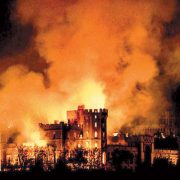Renovating and restoring property devastated by fire
When fire ripped through Oulton Hall, destroying the historic property in Norfolk, its owner was understandably devastated. But he was also adamant he would make the premises a happy family home once again. Nicholas Jacob Architects has played a huge part in making this happen.
Here Shaun Soanes explains how the company prides itself on renovating and restoring fire damaged buildings.
When we started work last year on Oulton Hall near Aylsham, it was a charred, scarred shell of its former self.
An 18th century building bursting with character, it had been gutted by an inferno fanned by high winds and needed lots of attention to bring it back to life.
The project to repair included replacing the black glazed roof tiles and stone floors as well as adding in some modern twists such as efficient insulation, double glazing and batteries to store solar power.
It has been complex, extensive and multifaceted work but restoring old buildings is part of our area of expertise and we worked in close association with conservation officers.
Our dedication has paid off. And now the building is rising like phoenix from the ashes.
From ruin to recognition
Oulton Hall was not the first stately home to catch fire. And it won’t be the last. After all, buildings of cultural heritage were built in other times, under different rules and with no standards of safety. We often use them in different ways then they were used in the time of their construction too. This means they are at greater risk. In the last few decades there have been a number of high profile examples of this:
- Windsor Castle
The Queen dubbed 1992 her “annus horribilis” after fire destroyed much of Windsor Castle. It sparked a public row over who should pay for repairs to the royal residence – taxpayers or the Royal Family – and as a result, the Queen said she would meet 70% of the restoration cost, opening Buckingham Palace to the public in order to generate extra funds. The work, which cost £37m, was completed ahead of schedule in 1997.
- Hampton Court
In 1986 Hampton Court hit the headlines when fire swept through the “grace and favour” apartment of 86-year-old widow Lady Daphne Gale, who unfortunately died in the blaze. The restorations were the biggest seen at the palace since the 1880s and were largely completed in 1995. Since then it has been argued that the fire transformed the former home of Henry VIII for the better.
- Witley Court
Witley Court in Worcestershire was one of England’s greatest country houses, until a fire ripped through it in 1937. The west side of the property was unaffected, but owner Sir Herbert Smith decided to sell the estate rather than rebuild the house. It was subsequently stripped for scrap, left to fall into further ruin and was never inhabited again. The ruins are among the most spectacular in England however, and visitors flock to see the impressive architecture and wander the landscaped gardens. The singer Bob Dylan even went ghost hunting at Witley Court in the mid-1960s.
The burning question: what’s involved in restoration?
Although we get involved in a wide range of construction projects, including new builds, we are perhaps best known for our restoration work – often on Grade I and Grade II listed buildings. This can involve repairs to buildings for a number of reasons but flood and fire are both areas we are highly trained in handling.
Our fire damage restoration techniques dramatically increase the likelihood of saving historic aspects and the basic fabric of a building without needing to replace it. We also work very closely with fire investigators, insurance companies and the property owner. The sooner we are brought on board the better. After all, in the case of a fire in an old building, the debris matters. This debris might include structural elements made of wood and steel, glass windows, panels or decorative pieces, which must be salvaged where possible. It’s all about early preservation. This can help architects like ourselves to protect significant character defining features on the building’s interior, which we can work with when restoring it. It can also help us recreate the floor plan when there is extensive damage and incorporate original interior architectural and decorative aspects where possible.
Often an archeology of debris is extensive – it makes you realise that there is more to the building than meets the eye.
Protect and preserve
Our research teams use the debris to determine the gaps in knowledge and prioritise the areas that needed more investigation. This might involve looking at photographs of the original building to help us to source materials to match those that were lost to the flames.
Faithful recreation and painstaking attention to detail are all key to a restoration project, but so too is looking for ways to make sure this type of disaster doesn’t happen again. This might involve incorporating more modern elements in the design such as better ventilation, as well as ways to to make it fit for contemporary living. After all, historic buildings are not museum exhibits. They are usually fully functioning properties, businesses or homes. Making a building fit for the future therefore, is just as important as preserving its history.






Leave a Reply
Want to join the discussion?Feel free to contribute!